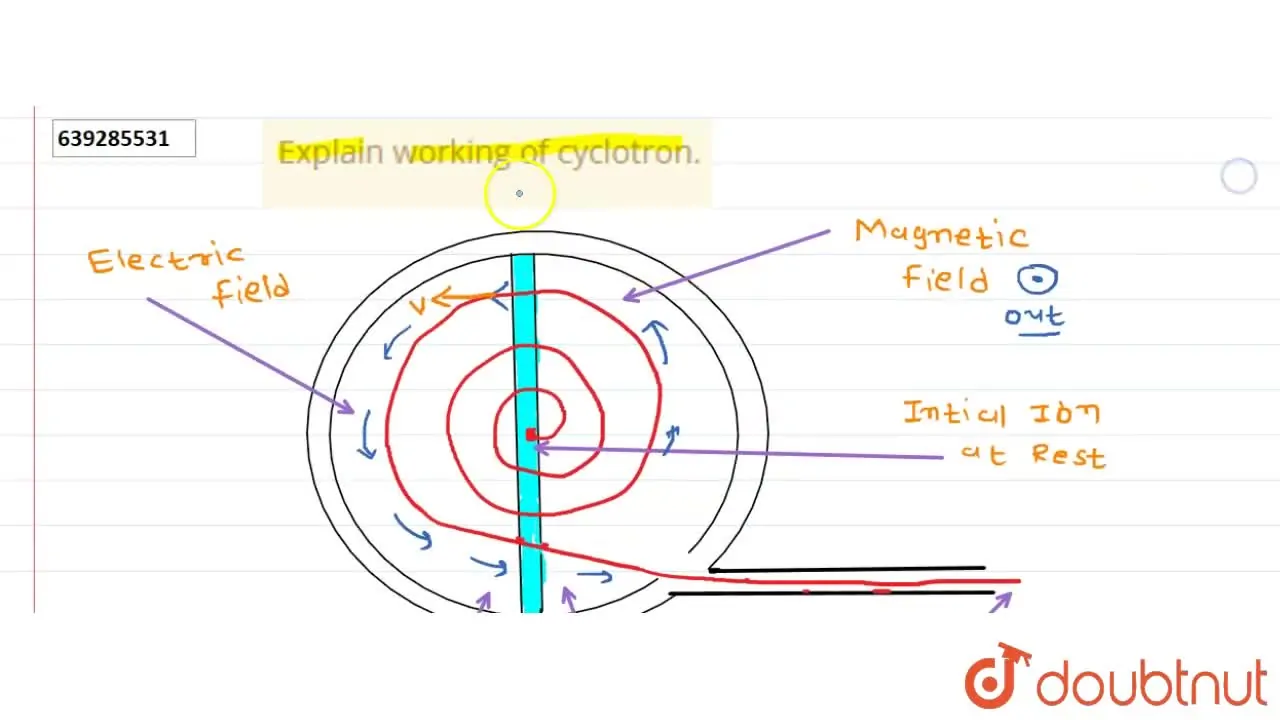Explain working of cyclotron.Solution in Gujrati
1. Figure shows a schematic view of the cyclotron.

2. Inside the metal boxes the particles is shielded and is not acted on by the electric field. (Electric field is prevailing only around two dees).
3. The magnetic field however acts on the particle and makes it go round in a circular path inside dee.
4. Every time the particle moves from one dee to another it is acted upon by the electric field.
5. The sign of the electric field is changed alternately in tune with circular motion of the particle. This ensures that the particle is always accelerated by the electric field. Each time the acceleration increases the energy of the particle. As energy increases, the radius of the circular path increases. So the path is a spiral one.
6. Charged particles (eg. proton) move in a semicircular path in one of the dees and arrive in the gap between the dees in time interval T2, where T the time period of revolution.
T=1VC=2πmqBorVC=qB2πm ...(1)
7. This frequency is called the cyclotron frequency and denoted by vc.
8. It is independent from speed of particle, momentum and kinetic energy.
9. The frequency va of the applied voltage is adjusted so that the polarity of the dees is reversed in the same time that it takes the ions to complete one half of the revolution. The requirement va=vc is called the resonance condition.
10. The phase of the supply is adjusted so that when the positive ions arrive at the edge of one dees another dees is at a lower potential and the ions are accelerated across the gap.
11. Inside the dees the particles travel in a region free of the electric field. The increase in their kinetic energy is qV each time they cross from one dee to another.
12. For circular motion, centripetal force = magnetic force,
mv2r=qvB
∴r=mvqB=pqB ...(2) where p is momentum
13. From this equation it is clear that the radius of their path goes on increasing each time their kinetic energy increases.
14. The ions are repeatedly accelerated across the dees until they have the required energy to have a radius approximately that of the dees. They are then deflected by a magnetic field and leave the system via an exit slit.
15. Speed of particle near Dee,
v=qBRm ...(3)
where R is the radius of the trajectory at exit and equals the radius of a dee.
16. Hence, the kinetic energy of the ion is,
12mv2=12m(qBRm)2
∴12mv2=12q2B2R2m ...(4)
17. Equation (1) and (2) indicates that,
(1) (1) The time for one revolution of an ion is independent of its speed or radius of its orbit.
(2) But, its kinetic energy depend on it radius of path. (By increasing speed, radius of the circle increase but frequency vc remain constant).
Related Playlists
- BOOK - KUMAR PRAKASHANCHAPTER - MOVING CHARGES AND MAGNETISMEXERCISE - SECTION A (TRY YOURSELF)89videos
MOVING CHARGES AND MAGNETISM
- BOOK - KUMAR PRAKASHANCHAPTER - MOVING CHARGES AND MAGNETISMEXERCISE - SECTION B (NUMERICAL FROM TEXTUAL ILLUSTRATIONS)22videos
MOVING CHARGES AND MAGNETISM
- BOOK - KUMAR PRAKASHANCHAPTER - MAGNETISM AND MATTEREXERCISE - SECTION D Multiple Choice Questions (MCQs) (MCQs asked in Competitive Exams) MCQs asked in Board Exam and GUJCET7videos
MAGNETISM AND MATTER
- BOOK - KUMAR PRAKASHANCHAPTER - RAY OPTICS AND OPTICAL INSTRUMENTSEXERCISE - SECTION-D (MULTIPLE CHOICE QUESTIONS (MCQs))(MCQs ASKED IN COMPETITIVE EXAMS)142videos
RAY OPTICS AND OPTICAL INSTRUMENTS
Similar Questions
State Oersted's experiment.
02:03View SolutionA straight wire of mass 200 g and length 1.5 m carries a current of 2 A. It is suspended in mid air by a uniform horizontal magnetic field B (figure). What is the magnitude of the magnetic field ?
 05:37View Solution
05:37View SolutionAt a place on earth the vertical component of earth's magnetic field is √3 times its horizontal component. The angle of dip at this place is …...
05:37View SolutionWhich of the following is used in optical fibres ?
05:37View SolutionState the principle of working of a cyclotron.
04:33View SolutionExplain the principle and working of a cyclotron with the help of a schematic diagram. Write the expression for cyclotron frequency.
06:54View SolutionWhat is a cyclotron? Discuss its construction, working and theory. Explain cyclotron frequency.
04:33View SolutionExplain the principle and working of a cyclotron with the help of a schematic diagram. Write the expression for cyclotron frequency.
04:33View SolutionDiscuss the working of cyclotron in detail.
View Solutionसाइक्लोट्रॉन के सिद्धांत को समझाइए।
View SolutionDiscuss the working of cyclotron in detail.
03:09View SolutionDiscuss the working of cyclotron in detail.
05:00View SolutionExplain the principle, construction and working of a cyclotron.
08:22View SolutionWrite working principle of cyclotron and with a suitable diagram explain its working. Give any two application of cyclotron.
05:21View SolutionExplain construction of cyclotron with diagram.
View Solution


